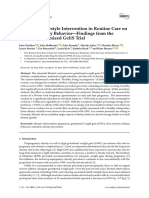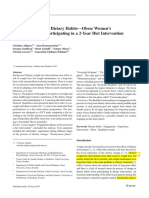Gestational Diabetes Mellitus Can Be Prevented by Lifestyle Intervention:The Finnish Gestational Diabetes Prevention Study (RADIEL)
Gestational Diabetes Mellitus Can Be Prevented by Lifestyle Intervention:The Finnish Gestational Diabetes Prevention Study (RADIEL)
Uploaded by
Daniela PopCopyright:
Available Formats
Gestational Diabetes Mellitus Can Be Prevented by Lifestyle Intervention:The Finnish Gestational Diabetes Prevention Study (RADIEL)
Gestational Diabetes Mellitus Can Be Prevented by Lifestyle Intervention:The Finnish Gestational Diabetes Prevention Study (RADIEL)
Uploaded by
Daniela PopOriginal Title
Copyright
Available Formats
Share this document
Did you find this document useful?
Is this content inappropriate?
Copyright:
Available Formats
Gestational Diabetes Mellitus Can Be Prevented by Lifestyle Intervention:The Finnish Gestational Diabetes Prevention Study (RADIEL)
Gestational Diabetes Mellitus Can Be Prevented by Lifestyle Intervention:The Finnish Gestational Diabetes Prevention Study (RADIEL)
Uploaded by
Daniela PopCopyright:
Available Formats
Gestational Diabetes Mellitus Can Be Prevented by Lifestyle
Intervention:The Finnish Gestational Diabetes Prevention
Study (RADIEL)
A Randomized Controlled Trial
Diabetes Care 2016;39:24–30 | DOI: 10.2337/dc15-0511
Saila B. Koivusalo, Kristiina R¨on¨o, Miira M. Klemetti, Risto P. Roine, Jaana Lindstr¨om, Maijaliisa Erkkola, Risto J.
Kaaja, Maritta P¨oyh¨onen-Alho, Aila Tiitinen, Emilia Huvinen, Sture Andersson, Hannele Laivuori, Anita Valkama,
Jelena Meinil¨a, Hannu Kautiainen,Johan G. Eriksson, and Beata Stach-Lempinen
Dr. ANUTA POP
MEDIC REZIDENT MEDICINA DE FAMILIA
OBJECTIVE
To assess whether gestational diabetes mellitus
(GDM) can be prevented by a moderate
lifestyle intervention in pregnant women who
are at high risk for the disease.
RESEARCH DESIGN AND METHODS
The study was conducted between February 2008 and January 2014 in all
three maternity hospitals of the Helsinki metropolitan area and in the South-
Karelia Central Hospital in Lappeenranta, in Finland.
Eligible participants for the study were women aged >=18 years, pregnant
at,<20 weeks of gestation, with a history of GDM and/or a prepregnancy BMI
of >=30 kg/m2.
The diagnosis of GDM was based on a 75-g, 2-h oral glucose tolerance test at
24–28 weeks of gestation. All participants underwent an OGTT at the time of
study enrollment and again at 24–28 weeks of gestation (second trimester)
unless insulin or metformin treatment was initiated earlier.
Exclusion criteria were type 1 or type 2 diabetes, or GDM diagnosed before
20 weeks of gestation; use of medication that influences glucose metabolism,
such as continuous therapy with oral corticosteroids or metformin; multiple
pregnancy; physical disability; severe psychiatric disorder; and significant
difficulty in cooperating (e.g., inadequate Finnish language skills).
Flowchart of the RADIEL study.
Saila B. Koivusalo et al. Dia Care 2016;39:24-30
©2016 by American Diabetes Association
The intervention design and study methods
The participants in the INTERVENTION GRUP received
lifestyle counseling from study nurses and dietitians who were
specifically trained for their tasks.
The participants visited the study nurse three times during
pregnancy (13-23-35 weeks of gestation).
At the time of study enrollment, the participants attended one 2-
h group counseling session led by a dietitian.
The dietary counseling focused on optimizing participants’
consumption of vegetables, fruits and berries, whole-grain
products rich in fiber, low-fat dairy products, vegetable fats high
in unsaturated fatty acids, fish, and low-fat meat products, and a
lower intake of sugar-rich foods.
Regarding physical activity, the aim was to achieve a minimum
of 150 min of moderate-intensity physical activity per week and
to adopt an overall active lifestyle.
In the CONTROL GROUP, participants received general
information leaflets on diet and physical activity usually
provided by local antenatal clinics. Also, during pregnancy
the control group participants visited the study nurse three
times, to make measurements, obtain blood samples, and
administer questionnaires, as well as antenatal clinics
according to standard practice.
Demographic and clinical characteristics did
not differ between the intervention group and
the control group at baseline (Table 1).
RESULTS
GDM was diagnosed in 20 participants (13.9%) in the
intervention group and in 27 participants (21.6%) in the control
group
There was a difference in gestational weight gain between the
intervention group (2.5 kg ) and the control group (3.1 kg ) from
baseline to the second trimester
The gestational weight gain was 7.6 kg in the intervention group
and 7.7 kg in the control group from baseline to the third
trimester.
Women in the intervention group increased their median weekly
leisure time physical activity by 15 min while the physical
activities of women in the control group remained unchanged.
There were no differences in the other maternal pregnancy or
birth outcomes assessed between the intervention and the control
group (Table 2).
CONCLUSIONS
A moderate individualized lifestyle intervention
reduced the incidence of GDM by 39% in high-risk
pregnant women.
Despite the fact that only a small proportion of the
women in the intervention group reached the physical
activity goals, and the difference in weight gain was
modest between the groups, it is obvious that the
individual changes in lifestyle do not need to be
large, but together they have a beneficial effect on
the reduction of the incidence of GDM.
These findings may have major health consequences
for both the mother and the child.
You might also like
- A Case Presentation of An Adult With Gestational Diabetes Mellitus FinalNo ratings yetA Case Presentation of An Adult With Gestational Diabetes Mellitus Final59 pages
- Correlation Between Dietary Diversity, Fermented Food Intake, and Blood Glucose Control in Patients with Type 2 DiabetesNo ratings yetCorrelation Between Dietary Diversity, Fermented Food Intake, and Blood Glucose Control in Patients with Type 2 Diabetes13 pages
- Effects of High Performance Inulin Supplementation On Glycemic Control and Antioxidant Status in Women With Type 2 DiabetesNo ratings yetEffects of High Performance Inulin Supplementation On Glycemic Control and Antioxidant Status in Women With Type 2 Diabetes9 pages
- Pilot Project For Education of Gestational Diabetes Mellitus (GDM) Patients - Can It Be Beneficial?No ratings yetPilot Project For Education of Gestational Diabetes Mellitus (GDM) Patients - Can It Be Beneficial?5 pages
- An Integrated Intervention Program To Control Diabetes in Overweight Chinese Women and Men With dm2No ratings yetAn Integrated Intervention Program To Control Diabetes in Overweight Chinese Women and Men With dm211 pages
- Randomized Controlled Trial of The Medifast 5 & 1 Plan For Weight LossNo ratings yetRandomized Controlled Trial of The Medifast 5 & 1 Plan For Weight Loss8 pages
- Outi Pellonper A, Kati Mokkala, Noora Houttu, Tero Vahlberg, Ella Koivuniemi, Kristiina Tertti, Tapani R Onnemaa, and Kirsi LaitinenNo ratings yetOuti Pellonper A, Kati Mokkala, Noora Houttu, Tero Vahlberg, Ella Koivuniemi, Kristiina Tertti, Tapani R Onnemaa, and Kirsi Laitinen9 pages
- Hindawi Journal of Diabetes Research Volume j2021, Article ID 8862217No ratings yetHindawi Journal of Diabetes Research Volume j2021, Article ID 88622177 pages
- Journal of Nutrition College, Volume 4, Nomor 1, Tahun 2015No ratings yetJournal of Nutrition College, Volume 4, Nomor 1, Tahun 20158 pages
- Diabetes Reversal by Plant Based Diet Dr. BiswaroopNo ratings yetDiabetes Reversal by Plant Based Diet Dr. Biswaroop18 pages
- Fases Do Plano Alimentar Engajamento em Novos Hábitos Alimentares - Mulheres ObesasNo ratings yetFases Do Plano Alimentar Engajamento em Novos Hábitos Alimentares - Mulheres Obesas10 pages
- Central Obesity of Housewives in Dukuh Tapen, Ngrandu Village, Geyer District, Grobogan RegencyNo ratings yetCentral Obesity of Housewives in Dukuh Tapen, Ngrandu Village, Geyer District, Grobogan Regency11 pages
- Physical Activity and Dietary Habits During Pregnancy: Effects On Glucose ToleranceNo ratings yetPhysical Activity and Dietary Habits During Pregnancy: Effects On Glucose Tolerance6 pages
- The Effect of a Structured Dietary Intervention on Weight Loss in Overweight Individuals with Type 1 Diabetes (www.kiu.ac.ug)No ratings yetThe Effect of a Structured Dietary Intervention on Weight Loss in Overweight Individuals with Type 1 Diabetes (www.kiu.ac.ug)4 pages
- Exenatide Response in An Adolescent's Morbid Obesity: Pharmacology & Pharmacy, 2014, 5, 419-424No ratings yetExenatide Response in An Adolescent's Morbid Obesity: Pharmacology & Pharmacy, 2014, 5, 419-4246 pages
- Gestational Diabetes Mellitus - Glycemic Control and Maternal Prognosis - UpToDateNo ratings yetGestational Diabetes Mellitus - Glycemic Control and Maternal Prognosis - UpToDate46 pages
- Promosi Kesehatan Dengan Model Sesama Berpengaruh Terhadap Kepatuhan Makan Pasien DM Tipe 2No ratings yetPromosi Kesehatan Dengan Model Sesama Berpengaruh Terhadap Kepatuhan Makan Pasien DM Tipe 214 pages
- Nutritional Status, Eating Habits and Foods Intake by Gestational Diabetes Patients in National Hospital of EndocrinologyNo ratings yetNutritional Status, Eating Habits and Foods Intake by Gestational Diabetes Patients in National Hospital of Endocrinology9 pages
- Ffective For The Control of Gestational: Physical Activity Programs During Pregnancy Are E Diabetes MellitusNo ratings yetFfective For The Control of Gestational: Physical Activity Programs During Pregnancy Are E Diabetes Mellitus14 pages
- Vegetarian and Vegan Diets in Type 2 DiabetesNo ratings yetVegetarian and Vegan Diets in Type 2 Diabetes9 pages
- Regular Exercise During Pregnancy To Prevent Gestational DiabetesNo ratings yetRegular Exercise During Pregnancy To Prevent Gestational Diabetes8 pages
- Atendimento Ambulatorial Individualizado Versus Programa de Educação em Grupo: Qual Oferece Mais Mudança de Hábitos Alimentares e de Atividade Física em Crianças Obesas?No ratings yetAtendimento Ambulatorial Individualizado Versus Programa de Educação em Grupo: Qual Oferece Mais Mudança de Hábitos Alimentares e de Atividade Física em Crianças Obesas?7 pages
- Evaluation of The 'Healthy Start To Pregnancy' Early Antenatal Health Promotion Workshop: A Randomized Controlled TrialNo ratings yetEvaluation of The 'Healthy Start To Pregnancy' Early Antenatal Health Promotion Workshop: A Randomized Controlled Trial12 pages
- 49. Rosi et al 2020 Body weight of obese decreases after high or low pastaNo ratings yet49. Rosi et al 2020 Body weight of obese decreases after high or low pasta12 pages
- Research: Cite This As: BMJ 2010 341:c3337No ratings yetResearch: Cite This As: BMJ 2010 341:c33377 pages
- Complementary and Alternative Medical Lab Testing Part 10: ObstetricsFrom EverandComplementary and Alternative Medical Lab Testing Part 10: ObstetricsNo ratings yet
- Global Initiative For Asthma (GINA) What's New in GINA 2020?No ratings yetGlobal Initiative For Asthma (GINA) What's New in GINA 2020?35 pages
- Alcohol Abstinence in Drinkers With Atrial FibrillationNo ratings yetAlcohol Abstinence in Drinkers With Atrial Fibrillation16 pages
- Lesson 1: The Health Education Team Let'S EngageNo ratings yetLesson 1: The Health Education Team Let'S Engage3 pages
- Different Field of Nursing: Geronimo C. Burce JRNo ratings yetDifferent Field of Nursing: Geronimo C. Burce JR44 pages
- Optimizing Anti-Inflammatory Activities of Arabica Coffee Ground (Coffea Arabica L.) Nanoparticle GelNo ratings yetOptimizing Anti-Inflammatory Activities of Arabica Coffee Ground (Coffea Arabica L.) Nanoparticle Gel9 pages
- NURS FPX 6030 Assessment 3 Intervention Plan DesignNo ratings yetNURS FPX 6030 Assessment 3 Intervention Plan Design8 pages
- Resume: S.Nageswara Rao, S/O Subbaiah, Mobile:9493238359 Email Singalanageswararao8@g-Mail ObjectiveNo ratings yetResume: S.Nageswara Rao, S/O Subbaiah, Mobile:9493238359 Email Singalanageswararao8@g-Mail Objective2 pages
- A Practical Guide To Transgender Life and How You Can Help - Lorelei AuroraNo ratings yetA Practical Guide To Transgender Life and How You Can Help - Lorelei Aurora18 pages
- Covid Nawg Anticipatory Impacts and Needs AnalysisNo ratings yetCovid Nawg Anticipatory Impacts and Needs Analysis94 pages
- SPDC Standard Drilling Procedures Manual: Waste Management Page 1 of 41No ratings yetSPDC Standard Drilling Procedures Manual: Waste Management Page 1 of 4141 pages
- How Much Does Seawater Desalination Cost?: Nikolay Voutchkov, PE, BCEENo ratings yetHow Much Does Seawater Desalination Cost?: Nikolay Voutchkov, PE, BCEE21 pages
- Environmental Management Plan Final 2021 2026No ratings yetEnvironmental Management Plan Final 2021 202621 pages
- A Case Presentation of An Adult With Gestational Diabetes Mellitus FinalA Case Presentation of An Adult With Gestational Diabetes Mellitus Final
- Correlation Between Dietary Diversity, Fermented Food Intake, and Blood Glucose Control in Patients with Type 2 DiabetesCorrelation Between Dietary Diversity, Fermented Food Intake, and Blood Glucose Control in Patients with Type 2 Diabetes
- Effects of High Performance Inulin Supplementation On Glycemic Control and Antioxidant Status in Women With Type 2 DiabetesEffects of High Performance Inulin Supplementation On Glycemic Control and Antioxidant Status in Women With Type 2 Diabetes
- Pilot Project For Education of Gestational Diabetes Mellitus (GDM) Patients - Can It Be Beneficial?Pilot Project For Education of Gestational Diabetes Mellitus (GDM) Patients - Can It Be Beneficial?
- An Integrated Intervention Program To Control Diabetes in Overweight Chinese Women and Men With dm2An Integrated Intervention Program To Control Diabetes in Overweight Chinese Women and Men With dm2
- Randomized Controlled Trial of The Medifast 5 & 1 Plan For Weight LossRandomized Controlled Trial of The Medifast 5 & 1 Plan For Weight Loss
- Outi Pellonper A, Kati Mokkala, Noora Houttu, Tero Vahlberg, Ella Koivuniemi, Kristiina Tertti, Tapani R Onnemaa, and Kirsi LaitinenOuti Pellonper A, Kati Mokkala, Noora Houttu, Tero Vahlberg, Ella Koivuniemi, Kristiina Tertti, Tapani R Onnemaa, and Kirsi Laitinen
- Hindawi Journal of Diabetes Research Volume j2021, Article ID 8862217Hindawi Journal of Diabetes Research Volume j2021, Article ID 8862217
- Journal of Nutrition College, Volume 4, Nomor 1, Tahun 2015Journal of Nutrition College, Volume 4, Nomor 1, Tahun 2015
- Diabetes Reversal by Plant Based Diet Dr. BiswaroopDiabetes Reversal by Plant Based Diet Dr. Biswaroop
- Fases Do Plano Alimentar Engajamento em Novos Hábitos Alimentares - Mulheres ObesasFases Do Plano Alimentar Engajamento em Novos Hábitos Alimentares - Mulheres Obesas
- Central Obesity of Housewives in Dukuh Tapen, Ngrandu Village, Geyer District, Grobogan RegencyCentral Obesity of Housewives in Dukuh Tapen, Ngrandu Village, Geyer District, Grobogan Regency
- Physical Activity and Dietary Habits During Pregnancy: Effects On Glucose TolerancePhysical Activity and Dietary Habits During Pregnancy: Effects On Glucose Tolerance
- The Effect of a Structured Dietary Intervention on Weight Loss in Overweight Individuals with Type 1 Diabetes (www.kiu.ac.ug)The Effect of a Structured Dietary Intervention on Weight Loss in Overweight Individuals with Type 1 Diabetes (www.kiu.ac.ug)
- Exenatide Response in An Adolescent's Morbid Obesity: Pharmacology & Pharmacy, 2014, 5, 419-424Exenatide Response in An Adolescent's Morbid Obesity: Pharmacology & Pharmacy, 2014, 5, 419-424
- Gestational Diabetes Mellitus - Glycemic Control and Maternal Prognosis - UpToDateGestational Diabetes Mellitus - Glycemic Control and Maternal Prognosis - UpToDate
- Promosi Kesehatan Dengan Model Sesama Berpengaruh Terhadap Kepatuhan Makan Pasien DM Tipe 2Promosi Kesehatan Dengan Model Sesama Berpengaruh Terhadap Kepatuhan Makan Pasien DM Tipe 2
- Nutritional Status, Eating Habits and Foods Intake by Gestational Diabetes Patients in National Hospital of EndocrinologyNutritional Status, Eating Habits and Foods Intake by Gestational Diabetes Patients in National Hospital of Endocrinology
- Ffective For The Control of Gestational: Physical Activity Programs During Pregnancy Are E Diabetes MellitusFfective For The Control of Gestational: Physical Activity Programs During Pregnancy Are E Diabetes Mellitus
- Regular Exercise During Pregnancy To Prevent Gestational DiabetesRegular Exercise During Pregnancy To Prevent Gestational Diabetes
- Atendimento Ambulatorial Individualizado Versus Programa de Educação em Grupo: Qual Oferece Mais Mudança de Hábitos Alimentares e de Atividade Física em Crianças Obesas?Atendimento Ambulatorial Individualizado Versus Programa de Educação em Grupo: Qual Oferece Mais Mudança de Hábitos Alimentares e de Atividade Física em Crianças Obesas?
- Evaluation of The 'Healthy Start To Pregnancy' Early Antenatal Health Promotion Workshop: A Randomized Controlled TrialEvaluation of The 'Healthy Start To Pregnancy' Early Antenatal Health Promotion Workshop: A Randomized Controlled Trial
- 49. Rosi et al 2020 Body weight of obese decreases after high or low pasta49. Rosi et al 2020 Body weight of obese decreases after high or low pasta
- Complementary and Alternative Medical Lab Testing Part 10: ObstetricsFrom EverandComplementary and Alternative Medical Lab Testing Part 10: Obstetrics
- Global Initiative For Asthma (GINA) What's New in GINA 2020?Global Initiative For Asthma (GINA) What's New in GINA 2020?
- Alcohol Abstinence in Drinkers With Atrial FibrillationAlcohol Abstinence in Drinkers With Atrial Fibrillation
- Optimizing Anti-Inflammatory Activities of Arabica Coffee Ground (Coffea Arabica L.) Nanoparticle GelOptimizing Anti-Inflammatory Activities of Arabica Coffee Ground (Coffea Arabica L.) Nanoparticle Gel
- NURS FPX 6030 Assessment 3 Intervention Plan DesignNURS FPX 6030 Assessment 3 Intervention Plan Design
- Resume: S.Nageswara Rao, S/O Subbaiah, Mobile:9493238359 Email Singalanageswararao8@g-Mail ObjectiveResume: S.Nageswara Rao, S/O Subbaiah, Mobile:9493238359 Email Singalanageswararao8@g-Mail Objective
- A Practical Guide To Transgender Life and How You Can Help - Lorelei AuroraA Practical Guide To Transgender Life and How You Can Help - Lorelei Aurora
- Covid Nawg Anticipatory Impacts and Needs AnalysisCovid Nawg Anticipatory Impacts and Needs Analysis
- SPDC Standard Drilling Procedures Manual: Waste Management Page 1 of 41SPDC Standard Drilling Procedures Manual: Waste Management Page 1 of 41
- How Much Does Seawater Desalination Cost?: Nikolay Voutchkov, PE, BCEEHow Much Does Seawater Desalination Cost?: Nikolay Voutchkov, PE, BCEE































































































